It’s been a very long time since my last post. Ten months to be precise. I guess life took over and I found myself with less time and energy to devote to documenting my thoughts and feelings about my life in Japan. I regret this; and have recently found myself thinking that I really ought to put pen to paper, or rather, fingers to keypad once more. The fact that I have only four months left in Sendai, coupled with a recent flurry of “are you going to write another blog entry?” queries from friends and family have cemented my resolve. So here I am, back and ready to write again!
As many of you may know, I spent the latter part of 2012 constantly busy and more than a little stressed, due to two big events in early December that I (bravely? Foolishly?) signed up for. They fell within only one week of each other; and in hindsight it probably would have been sensible to focus on one, rather than both ventures. However, challenging myself and trying new things is my passion, so of course, I jumped in feet-first and took on both.
My first endeavor was attempting the Japanese Language Proficiency Test; a listening and reading exam designed to test competency in Japanese. I arrived in Japan in August 2011 with absolutely no Japanese skills at all, unable even to write my own name. I had to carry a cheat sheet around with me at all times, in case I needed to do an obligatory on the spot self-introduction, or in case someone asked me where I lived, where I was from, how old I was. I literally knew nothing. However, through determined but often reluctant self-study and weekly classes, I’ve progressed from a mute being who can’t comprehend anything that’s going on around me, to someone who, although still very much occasionally sounding like an idiotic child, can function fairly competently in everyday life. I wanted something to show for my hours of brain-straining study, so I decided to take the JLPT in early December.
Due to my aforementioned tenacity and a deep-rooted need to push myself to my limits, I opted to take a level higher than I should have done, with the belief that I would learn far more studying for that level than the lower level. A great theory (in theory), but what it also meant was that I had to spend the entire late autumn and winter cramming in as much study as I could. In between classes, at lunchtime, in the evenings, at weekends, on trains, buses, planes, boats, bullet trains, in my sleep; you name the time and place- I studied there! I tried my best, and was prepared for the exam to be extremely difficult, nigh impossible. I was right. No way have I passed, I thought. My low self expectations were duly fulfilled when the results came out and I saw the lovely word “FAIL” plastered across my screen. Wonderful. Ah well, after a day of wallowing and chastising myself quite horribly, I decided that worse things happen at sea. Onwards and upwards; if at first you don’t succeed, try try again; etc. And after I dissected my scores, I found that I actually didn’t do as badly as I first thought.
But this is not a self-study soliloquy. It is thankfully my second winter venture that is the focus of this post; that of how I learned the traditional Japanese art of kimono kitsuke (dressing) in a mere three months, before taking part in a national Kimono Dressing competition. It’s something I’m very proud of, and something that I want to commit to memory, so here goes.
I have always been fascinated by kimono. Surely there has never been a more exquisite, intricate, elegant, colourful, refined, detailed (insert various other superlatives) item of clothing to put on your back. In fact, when I began to study Japanese and learned the literal translation of kimono– something to wear; I was shocked and almost indignant that something so beautiful could have such a mundane name. But that’s Japanese for you- ever modest and unpretentious. Throughout my adult life I have devoured both fictional and factual books about geisha, that most famous and sadly misunderstood symbol of Japan. Their beauty, mystery, and utter devotion to their gruelling training and careers instil the greatest respect and admiration in me. A geisha, with her years of training in traditional Japanese arts such as tea ceremony, calligraphy, singing, shamisen-playing and dance, is like a living museum of traditional Japanese culture. The ubiquitous kimono she wears, the stunning kanzashi (ornaments) in her hair, the beautiful dancing fan she carries; all these things seem to represent the highest achievements in the traditional Japanese arts. Seeing a real geisha, or rather, geiko, as they’re known in local dialect; rushing to work at dusk in Gion, Kyoto and Japan’s most traditional and respected geisha district, is one of my top experiences in Japan.
The exquisite and refined, yet subtle and understated beauty of a geisha and her modest kimono, compared with the bright, eye-catching, almost garish colours and patterns in the kimono of her child-like younger sister, the maiko, or apprentice geisha, fascinate and enthrall me. Although I was a little embarrassed at doing something so ‘touristy’, being dressed and made up like a maiko in Kyoto on New Year’s Eve 2011 was a truly wonderful experience. Kimono do something wonderful to the wearer. Partly due to the swathes of under-robes and padding one must wear beneath a kimono and the thick, heavy obi or sash, it’s very difficult to slouch, or walk lazily while wearing kimono. One is physically forced to sit, stand and walk as straight-backed as a child. But I think it’s more than that. The elegance, refinement and beauty of kimono makes you feel as elegant and graceful as the clothes you are wearing. When I wear kimono, I feel effortlessly poised, calm, and centred. I stand taller, with a straight back, and I find myself walking with my head held high. It’s a feeling that I wish I could carry with me all the time, even when I remove my kimono.

A shot from when I was made up and dressed like a maiko in Kyoto on New Year’s Eve 2011
So, that’s just a little background about my fascination with kimono. As you can imagine, when I got the chance to actually learn how to dress myself in this most iconic of clothes, I jumped at it. My friend told me she had been invited to train for and take part in the Kyuushu leg of the All Japan Kimono Competition in December and despite my already busy schedule I had an instant “Wow, I want to do that!” reaction. I registered my interest and in early October, three months before the competition, my training began.
My teacher, Uchino Sensei, a slight local woman of around 50 years old, with a kind face, warm demeanour and infectious laughter, couldn’t have been a more wonderful instructor. She has been practicing kitsuke for 27 years; almost my entire life. Amazingly, she even has her own teacher; a woman in her late eighties, which goes some way to illustrate the time it takes to perfect this most refined and precise of Japanese arts.
Uchino Sensei speaks no English at all, so my twice to thrice weekly lessons with her were not only practice in kimono, but in the Japanese language itself. I won’t lie; it was sometimes a real struggle to get home after a long day teaching, to grab a mere 30 minutes respite before Uchino Sensei arrived for a one or two hour lesson. That’s where the title of this entry comes from; the self-discipline required in committing to regular lessons and frequent solo practice, on top of studying for my Japanese exam was considerable. But I loved the evenings Uchino Sensei and I spent together in my apartment, kneeling in seiza on my tatami living room floor, folding, refolding and unfolding swathes of exquisite fabric as I slowly but surely got to grips with how to dress myself in full kimono regalia. She was unwaveringly patient with this awkward, clumsy, forgetful, ‘long-legged’ foreigner who probably butchered her language and her discipline. She would heap praise on my efforts; and even when I made mistakes, she was full of encouragement and made me feel like I was making real progress. It’s no easy feat to learn an ancient tradition in a language you can barely understand; and I think she understood and respected that. In fact, so much respect did she show me, that she insisted on calling me ‘Amy Sensei’- sensei being the honorific title given to teachers, doctors, lawyers and masters of an art or discipline. I was humbled by the respect she showed me. I was, after all, nothing more than an ignorant child in comparison to her; and it made me somewhat uncomfortable that a master of a traditional Japanese art, and someone old enough to be my mother would address me with that respectful honorific. Eventually, I told her (in garbled Japanese) that just ‘Amy’ was fine, and for one or two lessons she managed it. However, she soon reverted back to ‘Amy Sensei.’ To this day, she still uses this title whenever she talks to or emails me.
My first lesson was a joint one with my friend. Uchino Sensei dressed us both in the kimono and obi that she had chosen for us. I felt full of excitement; although I was also very daunted by the task in hand. There seemed an unending list of things to remember to do; as well as the order in which to do them. Even which hand you use at any given time is important. This is an art after all; and it’s an art that is purely about aesthetic beauty. Everything has to be just so; to show off the exquisite fabric and simple yet elegant shape of kimono to full effect. They can take years to produce and can cost several millions of yen to buy; so it’s understandable that kitsuke pays minute detail to every stage of the dressing process. Indeed, geisha often name their custom-made, one of a kind kimono, and they are given as much respect and reverence as any important piece of artwork.

In my opinion, one of the most fascinating things about kimono and obi is the care in which they are chosen and the rules which govern what can be worn when. Everything from the current season to the complexion, age and marital status of the wearer has a bearing on what colours, patterns and combinations are acceptable. Generally, married women wear much simpler and understated kimono of muted colours and patterns, with their obi tied in an uncomplicated style. These simple shapes and colours give them an air of mature grace, and of worldliness. Unmarried women, by contrast, wear kimono of brighter colours and more intricate patterns, with a vibrant obi tied in a more complicated style. Girls wear the brightest colours of all; and they look just like little jewels.
The kimono Uchino Sensei chose for me wasn’t one of my favourite green, blue or purple colours, but a dusky orange with an intricate and colourful pattern of traditional Japanese images. The collar was jade green however, one of my favourites. The obi too wasn’t one that immediately matched; in my uneducated opinion at least. It was black, patterned with red, white and gold butterflies. However, once Uchino Sensei had dressed me for the first time and I looked in the mirror, my opinion changed. Although unconventional, the colours really worked together. She had obviously chosen well and knew exactly what would suit me. I still prefer the superb shimmery blue-green kimono I wore when I was dressed as a maiko in Kyoto, but I became very attached to that orange kimono over the coming months.
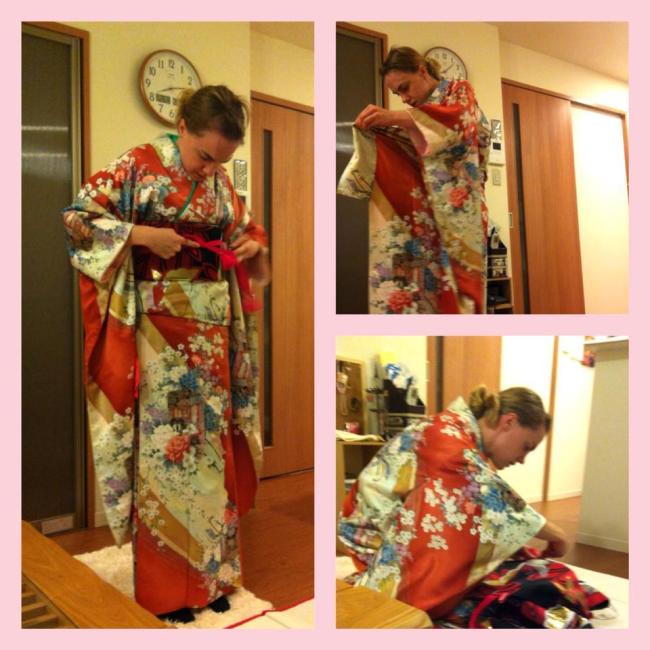
Practice, practice, practice
My routine over the next two months was much the same each week. As well as the three hour Saturday morning practice sessions I attended at a local culture centre with other kitsuke students, including one of my own High School boys (for there was a men and boys’ competition section too); Uchino Sensei would come to my apartment once or twice a week; increasing to three times a week in the month before the competition. We would practice together for an hour or an hour and a half; and she would offer advice and critique my efforts. Although she was obviously serious about and dedicated to her discipline, she was always light-hearted and full of fun; and often laughed uncontrollably at my comical demeanour and attempts to explain my frequent japes and ‘silly foreigner’ mistakes to her (those who know me well will understand what I mean by japes).
I tried to practice by myself at least once a week too, ever aware that the clock was ticking, quite literally. I found out early on that in the competition, we were expected to fold the obi, put on the kimono, and then put on the obi on stage, in front of 10 judges and an audience of around 1000 people, in no more than seven minutes. In the early days, it seemed like an impossible feat. But as I practiced more and became more dextrous at folding the fabric and remembering the order in which to do things, I gradually got faster and faster. If anything, I went a bit too fast, which ultimately proved to be my downfall on competition day. But more on that later.
The more local people I told about my new hobby and goal, the more I felt like I was doing something admirable. I can’t count the people, especially women, whose mouths dropped open in amazement when I told them I was learning how to dress myself in kimono. The fact is that kimono kitsuke has become a much less widely-practiced art than in its heyday. The popularity of Western clothing, the debilitating cost of traditional kimono, along with the difficulty in putting them on; combined with a recent trend for simpler, cheaper yukata (light, summer kimono often worn at festivals) and mass-produced, pre-folded obi that you can just slot into place; mean that fewer and fewer women and girls in Japan know how to dress themselves in the traditional clothing of their country. This strikes me as very sad. However, it’s not all doom and gloom. You can still see people in traditional dress fairly often, especially on special occasions and National Holidays such as January’s “Coming of Age Day”, when young adults who’ve turned 20 (Japan’s age of responsibility) in the previous year put on their finest and celebrate becoming an adult. So, it’s my personal hope that Japan’s youth don’t lose all interest in this most beautiful and refined part of their heritage.
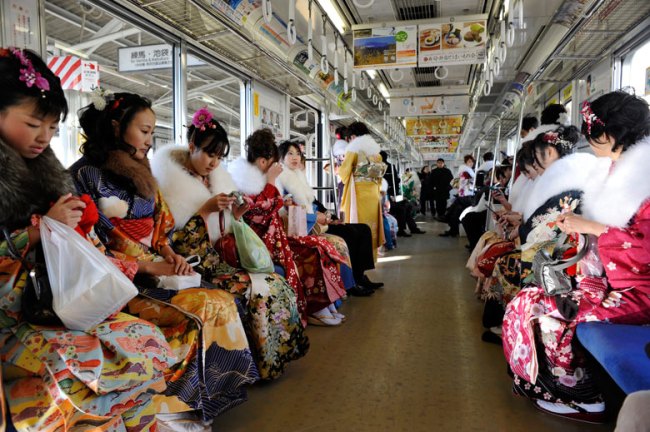
So, back to my tale of silken toil. As December the 9th drew ever nearer, I began to get more and more nervous. As something I’ve been interested in for so long and something I’d invested so much time and effort into, I really wanted to do my best. So I committed to yet more lessons and self-practice. I even found myself practicing in my head while I was at school or driving. I began to be pleased with my efforts, and found that it was becoming possible to match seams and collars and make smooth folds, without the help of the previously omnipresent mirror.
Now, just to give you an idea of what I was up against, I’ll talk about what dressing in full kimono regalia entails. While all you actually see is the gorgeous colours and patterns of the kimono and obi, they are really only the outer covers of an intricate, painstakingly applied and quite restrictive cocoon of layers, straps, wraps and clips. If you’ve ever tried eating, drinking or going to the toilet- and a Japanese squat toilet no less- in full kimono, then you will understand what I am talking about.
First, you have to choose a suitable base layer. Traditionally, kimono are worn with only the under robes; i.e. no Western underwear, but thankfully, I was permitted to wear leggings and a vest top under mine. White socks with the big toe separated are also worn; these are called tabi. The first stage of kitsuke is wrapping the body above the hip bones and below the bosom with a series of towels. This is to give the desired tube-like, curve-free shape that kimono require. No ladylike curves are wanted here! I was even told to wear a sports bra, to flatten me out. In complete contrast to modern Western women’s clothing, kimono are designed to hide any feminine curves. Now I am no J-Lo, but I am a twenty-eight year old Western woman, and even I have hips, curves and a slightly hourglass figure, so I had to wrap two towels around my middle to hide this. I enjoyed the sensation actually; it felt warm and cosy. The padding doesn’t end there. Next comes a rather amusing pad with a velco strap attached to it. This, if you please, is to flatten your derrière. It always gave me a pleasant surprise when after practice, I slowly peeled off my many layers and padding, to rediscover that yes, I do actually have feminine curves under all those layers!
Next is the first under robe; a thin, simple, short-sleeved white cotton robe which is tied behind with its sash. Then comes the lovely, silky main under robe; the kimono equivalent of a beautiful set of satin underwear. In this ilk, Uchino Sensei frequently reminded me not to reveal this robe on stage, as it’s the equivalent of flashing your bra and knickers. My robe was pale pink and patterned with flowers. It was cool and satiny soft; and I loved the almost liquid sensation of slipping it on. The collar, as was revealed to my surprise just before the competition, was white and embroidered with an exquisite pattern of pink and orange flowers. Uchino Sensei kept a temporary white cover over it to protect it until a week before the competition, which I had no idea about until she proudly ripped it off. This robe is a little more difficult to put on. You have to hold the ‘lapels’ and pull it backwards from the front, so that the back of the collar is in the middle of your back, reach behind, right up your own back to pass the sash ties through a loop, pull them forwards and tie it in front. After that, you have to pull it down in several places to smooth it. A beautifully smooth under robe means a beautiful smooth, wrinkle-free kimono. The reason for the pulling down is to reveal just a few vertebrae of the neck. This area was traditionally an alluring one in Japanese culture; and is indeed the only part of the body, as well as the face and hands, that is on show while wearing kimono.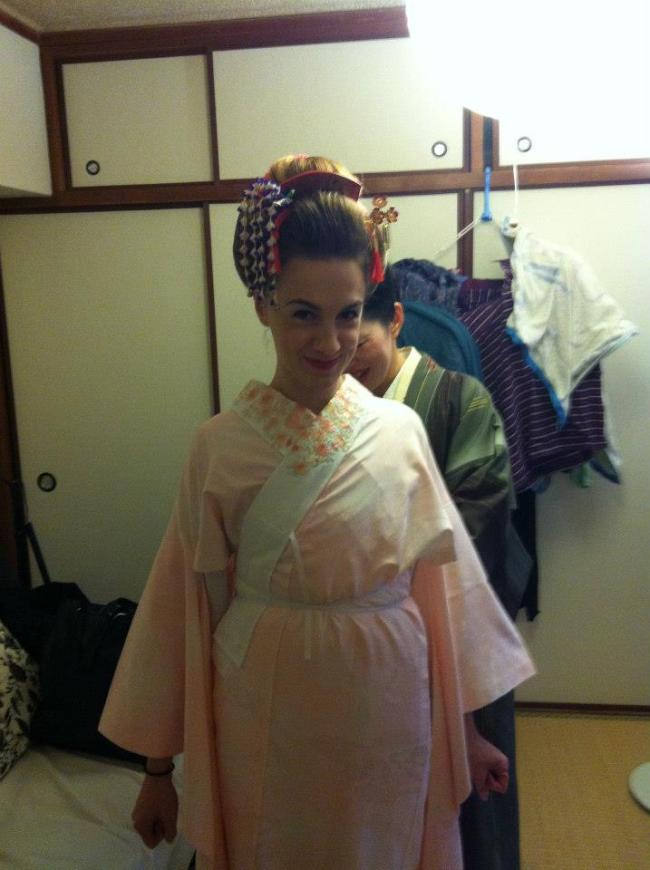
In my silky undies
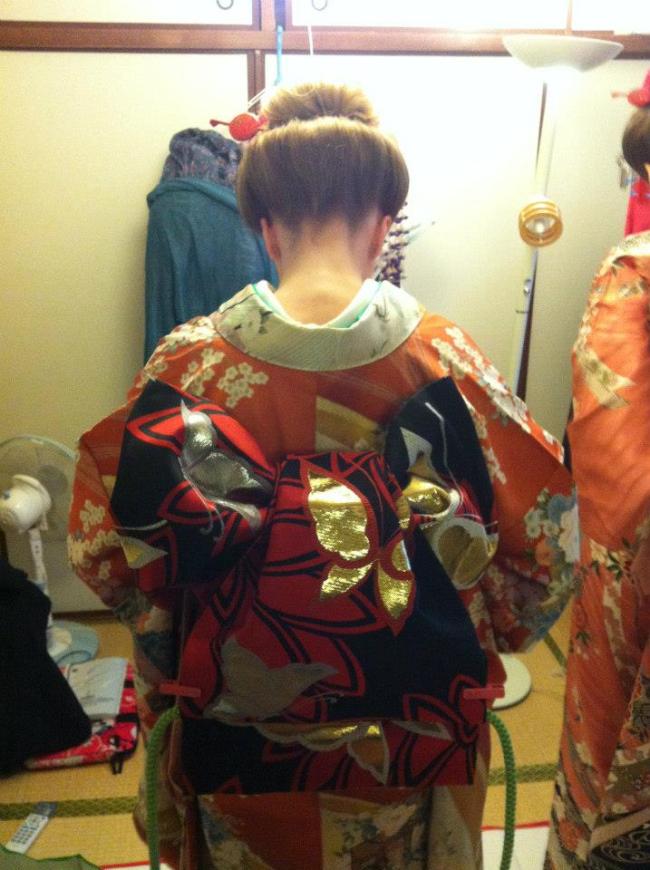
The back of the neck: kimono equivalent of a flash of leg or a hint of cleavage
Next comes the first hip wrap: a velco strap which you wrap tightly around your hips, unsurprisingly. This concludes the ‘underwear’ section of dressing in kimono. Another, wider strap follows, which is put tightly around the body just under the boobs. This is what the obi will be slotted in to. The next step is to put on the actual kimono, followed by the obi. For the competition, we were to go on stage already in all our padding and under robes, carrying our unfolded obi with the kimono on and strapped closed temporarily, to save our blushes. I was relieved when I learned this; as I’d had mortifying mental images of flashing my ‘underwear’ to the horrified judges and audience! On stage, we had to fold the obi, re-do the kimono properly, and then put on the obi; in my opinion the most difficult part of the whole process. I was told to kneel in seiza before the judges, and bow deeply and gracefully before beginning to fold the obi.
An obi is an integral part of kimono, and sometimes can cost more than the kimono itself. It’s a very long, wide strip of gorgeously coloured and patterned fabric, which one somehow has to fold into an intricate shape; in my case a kind of big bow. The bow goes in the middle of the upper back, with the unfolded part wrapping tightly around the middle of the body. Folding an obi is not at all unlike that other most famous of traditional Japanese arts: origami. The bow shape is made by securing the obi to a pink silk-covered contraption with various poppers and sashes. I unfortunately don’t know its name, but it’s a genius invention! It’s the centre of the whole obi masterpiece.
It’s quite difficult to explain how to fold an obi without showing you how to do it, so I’ll skim over this part and simply say that it involves a lot of folding, tugging and adjusting, and the clipping and unclipping of a decorative cord. After finishing the obi, it was time to re-do the kimono. This involved standing (very difficult in traditional Japanese clothing), standing at right angles to the judges to preserve modesty, and then wrapping the body in the main event. Again, this is quite difficult to explain without showing you, but suffice to say it involves the utmost precision and care in pulling, wrapping, folding, de-creasing and judging how much to pull the robe up. Too much, and the result will be a kimono that is too short. Not enough, and it’ll be too long and will be a tripping hazard. A clip and yet another Velcro strap holds it all in place. A final note is that all the seams have to match. Much easier said than done.
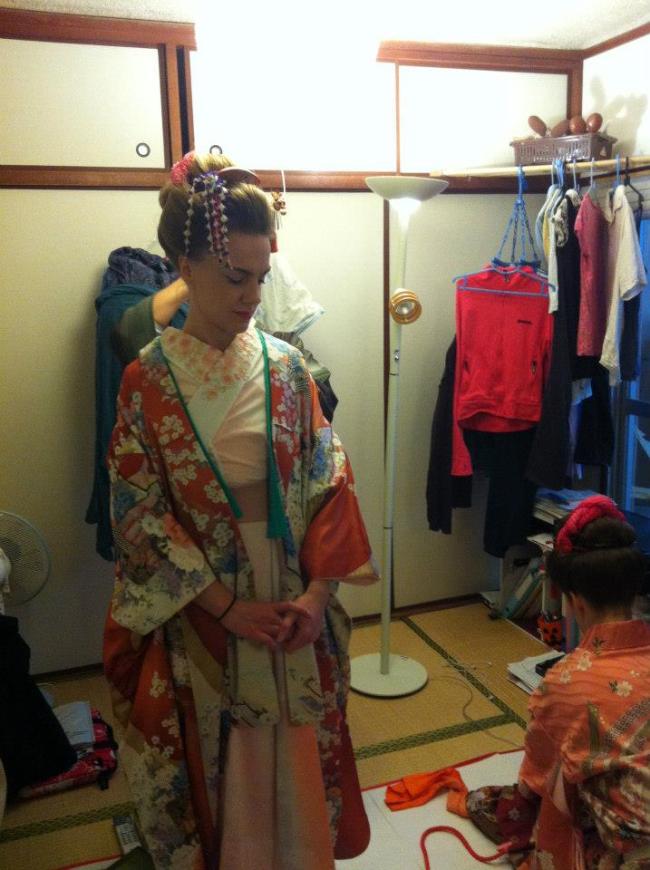
Then, it was time to kneel again and begin the task of actually putting on the obi. First, you have to slip in a plastic sheet called an obi-ita. It’s a stiffener that keeps the untied part of the obi flat. Then, while kneeling, and with the utmost grace and elegance (very difficult to do while kneeling and concentrating hard, not to mention wearing very long sleeves), you have to carefully hold the heavy tied obi, bring it in front of you and then behind onto your back, and ignoring the screaming protests of your back and arm muscles, you have to reach up as high as you can and slot the aforementioned ‘contraption’ into the wide wrap that you earlier put on. You are also not allowed to lift your bottom off your legs; because it is considered unsightly. This is the part I found most difficult; not least because I suffer from frequent back pain, but also because halfway through my training I had to have a lump removed from my back, exactly where the obi contraption and bow had to go. Looking back now, I’m amazed that I continued training in the days and weeks after my operation. I was exhausted and in a lot of pain. But I persevered, and Uchino Sensei was very kind and would help me with this part to ease my pain.
Next, you tie the obi contraption’s sashes firmly, and tie the decorative cord in front; a lesson in itself. That knot was difficult to master! Finally, the obiage is tied. An obiage is a scarf-like piece of cloth that keeps the upper part of the obi knot in place and adds another layer of colour and pattern to the whole ensemble. Mine was green and white with a pleasing dappled texture. These days it is customary for an unmarried young woman to let her obiage show from underneath the obi in the front. A married woman will tuck it deeper in and only allow it to peek out. Obiage can be thought of as an undergarment for kimono, so letting it show is seen as a little provocative. The last stage is to reach around (again, very difficult) and pull the ‘wings’ of the bow over your shoulders to straighten them out and hide the obi contraption; then remove the obi clips. Step into your zori (tiny sandals) and mince to the front of the stage for the judges to get a good look at you. Finished!
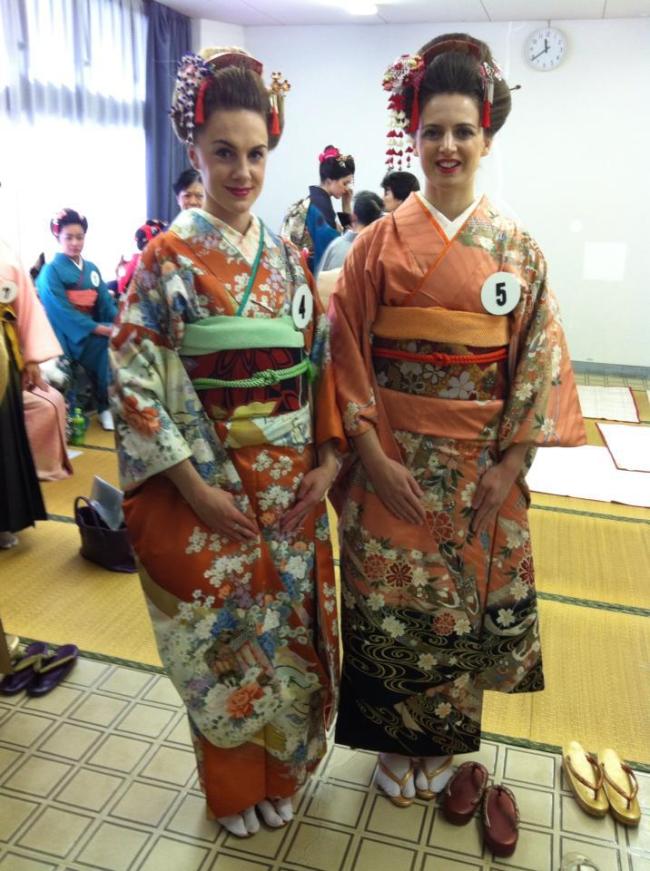
All done!
In November, I received a schedule for competition day which just about knocked me sideways. The day would start at the ungodly hour of 6 a.m, when we were to be at a local beauty salon for makeup and Nihon-gami; Japanese hair, or rather, the wareshinobu hairstyle distinctive of the maiko; complete with beautiful kanzashi hair ornaments. After that followed a non-stop day of activity, including a full dress rehearsal, before the actual competition itself. I calculated that I would be wearing the full kimono regalia, plus the zori sandals, from 8 a.m until at least 5 p.m. That is a very long time!
After a couple of hours at the salon, I’d been transformed from a sleepy, bleary-eyed bedrat into an elegant picture of femininity. From the neck up that is! It was pretty hilarious upon looking in the mirror; seeing myself staring back; my head a vision of elegance, but clad in a hoodie, trackpants and Ugg boots. Not so elegant. At the salon, we met three beautiful young sisters, who were all taking part in the children’s competition. We spent the next couple of hours gazing and smiling at each other in the mirror; they marvelling at my strange foreign-ness, me at their cuteness, flawless golden children’s skin and mirror-like glossy black hair. Children here really are the most beautiful I’ve ever seen.
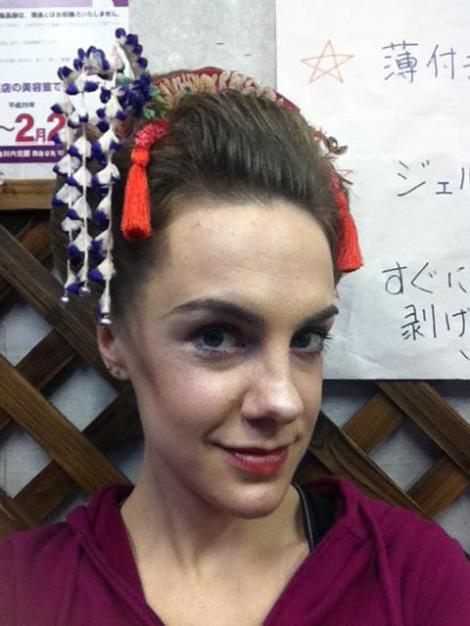
Transformed!
We headed back to the apartment to start the long dressing process; ready for the dress rehearsal. It was the first time I’d worn my kimono with my hair and make-up done; and it felt really different. I felt complete; finally the full picture. After dressing and making final checks that we had everything we’d need for the long day, we were driven to the Sendai Culture Hall, which very conveniently is only a couple of minutes away from the apartment building. Upon arriving, I was immediately aware of the bustling atmosphere at the Hall entrance as hundreds of people arrived. As I took in the number of competitors of all ages and both genders; and with quite a few non-Japanese faces too, all resplendent in their gorgeous clothes, I realised for the first time the scale and brevity of the competition. And I’ll admit, my stomach flipped a little. We ran into the little girls we’d met in the salon, and had some photos taken with them. They were so excited! Throughout the day, I kept bumping into them and they were just as excited each time.

With the lovely sisters we met at the beauty salon
My fellow non-Japanese competitors and I were herded together by a lady holding a helpful “外国人” (gaikokujin: foreign people) sign high above the many beautifully decorated heads, and we were all lead up to our very own tatami room, which would be our base for the day. It was good to meet the other international competitors, and compare notes and experiences. As well as me and my Northern Irish Sendai friend, there was another English girl, a Canadian, a Taiwanese, several Chinese, and three Filipino ladies. There was also one token man; an American who must have felt rather outnumbered! The atmosphere was nervous but excited as we waited to be called for the dress rehearsal.
I don’t remember much about the dress rehearsal except the stage lights being very hot, my feet hurting in the tiny zori and being constantly stunned at the almost overwhelming amount of gorgeous colours, patterns, fabrics and textures on show around me. Everyone really did look exquisite. After the long dress rehearsal, we headed back upstairs to wait and have an early lunch. Now, if you’ve never tried to eat in full kimono regalia; let me tell you, it is not easy! I’m sure it was partly nerves, but I could eat barely any of the bento (boxed lunch) that was kindly given to me. The many swathes of fabric and all the tight bands around the middle make it almost impossible to eat. Even a slight increase in stomach size makes you feel like you’re suffocating. I had to stop eating after only a minute because I genuinely felt like I couldn’t breathe. Drinking caused the same problem; and had the added downside of causing the need to use the toilet, which I will devote a paragraph to now…
This most mundane of tasks, performed while wearing the most beautiful but, let’s be honest, the most inconvenient clothes known to man, becomes an entirely different experience. No quick unzipping and doing your business in under one minute here, oh no. You have to tie your long sleeves together, tuck them into your obi, and proceed to start peeling back the many layers. When you’ve done this, you have to clip them together out of the way, with a special toilet clip. Then comes the fun of using an infamous Japanese squatter while trying to balance the weight of your hair ornaments and your kimono, while standing on tiny teetering little sandals. Not easy! Needless to say, after my first experience, I opted to drink as little as possible during the day.
Eating in kimono is no easier than performing one’s toilet. The many layers, coupled with the tight, restrictive hip wraps, mean that it is pretty much impossible for the stomach to expand, even slightly; and when it does, it is not a pleasant or comfortable feeling. We were kindly presented with free bento (boxed lunches) at around 11 a.m; but sadly I was unable to eat a few mouthfuls without feeling absolutely stuffed to the gills and unable to breathe! A very effective diet method. I spent the entire day fasting, with only a few sips of green tea to quench my parched throat.
So, after the dress rehearsal, and trying unsuccessfully to eat something, the waiting for our section began. It was nerve-wracking. Some competitors practised their routine, but I decided that I’d done all I could and that last minute cramming could confuse me. Much like sitting an exam! Instead, I opted for a quick power nap…

Time for forty winks
Finally, after a two hour wait, it was time to make our way on stage. I felt really nervous, but excited too. I’d worked so hard for three months, and it was finally time to put that hard work into action.
All I remember from actually being on stage was the heat and brightness of the lights, trying to remember to smile the whole time, trying not to fall over when standing up; and the pounding of my hammering heart which felt like it was right in my parched throat. I looked up at the audience a few times, and the only faces I could make out were those of the judges in the front row. There can only have been 600 or 700 people in the audience, but it felt like thousands.
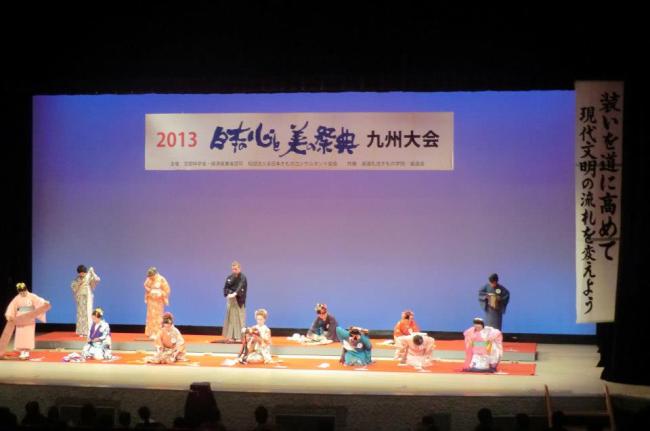
On stage (front, third from right)
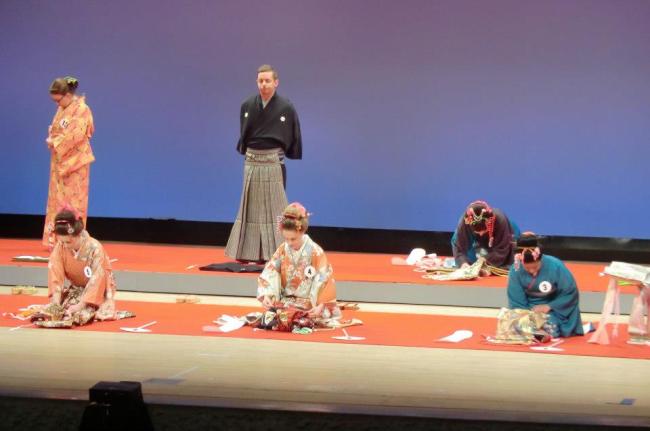
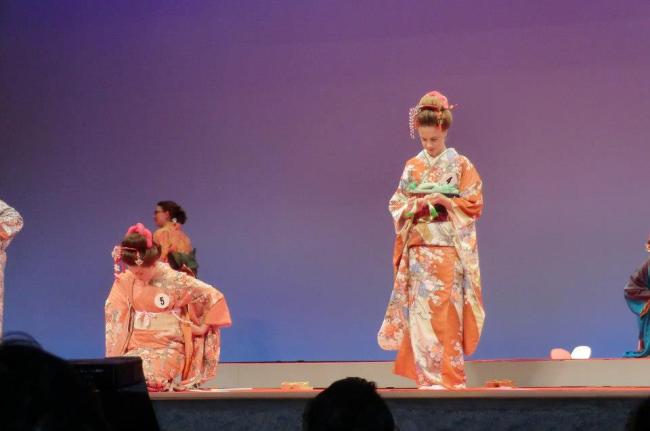
So, in less than ten minutes, it was all over. How did it go? Not great to be honest. Ever the perfectionist, I feel like I could have done a lot better. In my haste to finish within the seven minute time limit, I actually went too fast and made some silly mistakes such as pulling the right side of my kimono over too far, so that the seams on the left didn’t match up. Damn! That was something I always did well at during practice, and something Uchino Sensei had praised me on many times. The hem of my kimono was curled up, which I should have noticed and straightened out. I also forgot totally to take the obi clips out until I had actually shuffled to the front to show the judges my efforts. I had to discreetly reach up behind and try to remove them without detection.

Being judged
But oh well! Only a trained eye could spot my mistakes; and friends and family have told me, after seeing the photos, that they think I looked wonderful. So, although I was really disappointed in myself and actually had to choke back frustrated tears, I worked hard and did my best; and it was a wonderful experience. And what’s more, I am now trained in a traditional Japanese art, and that is something I am very proud of.
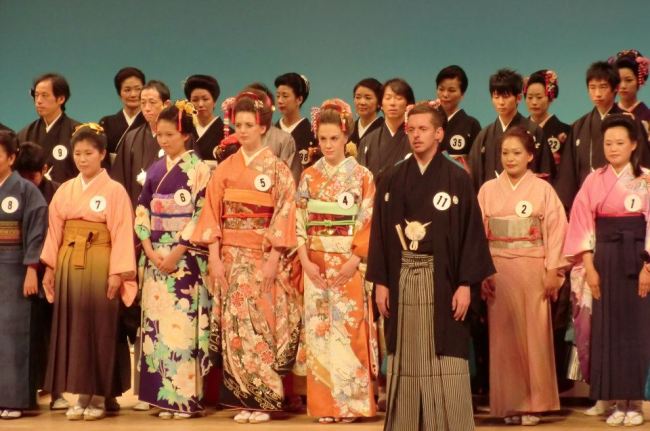
Waiting for the final results
By contrast, my friend did really well and got herself a silver second place trophy. This week, she will be travelling to Tokyo to take part in the grand final. Although frustrated with my own efforts, I was and am very happy for her. She worked even harder than me, and definitely deserved to come in second place! I will be thinking of her as she takes silk and self discipline to the next level in the big city.
After the foreigner section, we could finally relax and I enjoyed chatting with some of the other competitors. We re-dressed, correcting any errors so that we looked pretty for the end of the show. When the results were announced and the trophies handed out, we all gathered together on stage one last time to thank the audience and bow. After the show, we gathered in the foyer of the venue, and mingled with the audience. Conceited as it sounds, I relished those last moments of feeling so beautiful; and being admired! A highlight of the day was meeting my dear friends Matthew and Miyuki, who had kindly come to support me. It meant such a lot, because the tickets weren’t that cheap. I honestly felt how a child in a school play feels, when they see their parents in the audience! During the show I’d caught sight of Miyuki grinning and taking many of the above photos of me; and she was so moved when I met her in the foyer that she actually shed some tears. That really meant a lot. Matthew too was incredibly proud of me; and that was wonderful. Thank you to both of them for their support and encouragement!
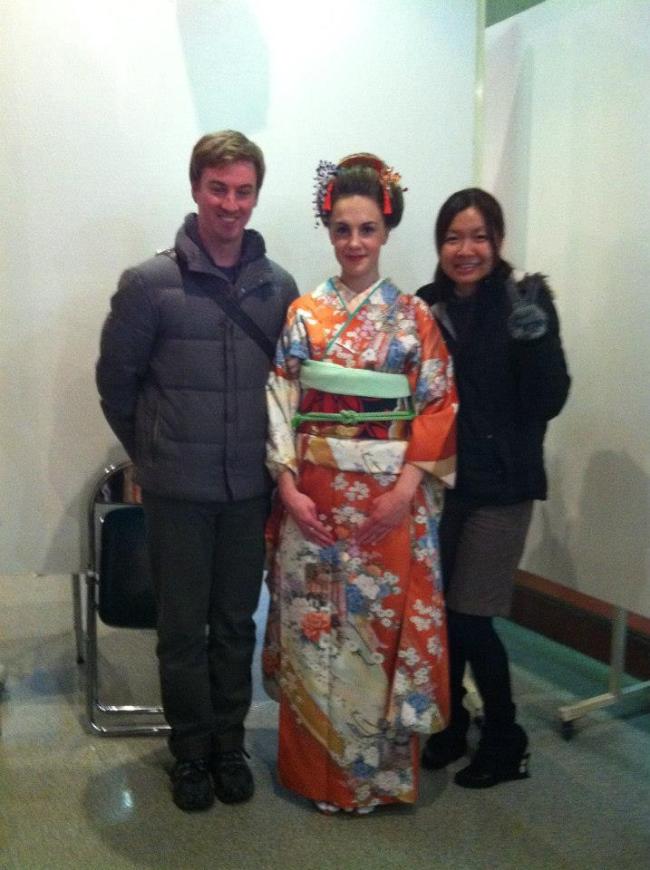
With my proud ‘Mum’ and ‘Dad’, Miyuki-chan and Matthew
What a day! It was wonderful, exciting and challenging but I was absolutely exhausted by the end of it. I had a professional photo taken; which I have framed and will treasure as a reminder of my experience with kimono; and indeed my life in Japan. I hope I never forget how to do it; and am considering buying my own kimono ensemble… after I’ve saved up a little!
I also got a certificate, which is proudly pinned on my kitchen wall. The words on it are rather lovely, so I will conclude this post by quoting them. I think they say a lot.
“As recognition of this individual, who has taken to heart the culturally different ways of traditional Japanese attire, participating in this Festival of Japanese Spirit and Beauty.”

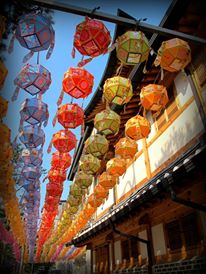 I slowly mended a broken heart in the spring, and found my smile again in time to thoroughly enjoy my last few months in Japan. Thank you to everyone who helped me through that difficult time. You know who you are.
I slowly mended a broken heart in the spring, and found my smile again in time to thoroughly enjoy my last few months in Japan. Thank you to everyone who helped me through that difficult time. You know who you are.
 I climbed several mountains over the year, in Japan and the USA. Most notably in July, the beautiful but beastly 3,776m Mount Fuji (thank goodness for oxygen canisters). I watched the sun rise from the top of Japan with about two thousand other people. It was very special.
I climbed several mountains over the year, in Japan and the USA. Most notably in July, the beautiful but beastly 3,776m Mount Fuji (thank goodness for oxygen canisters). I watched the sun rise from the top of Japan with about two thousand other people. It was very special.
 In August I lay on hot white sand beaches; and swam in turquoise seas with tropical fish in Okinawa, Japan’s southern island paradise. It was the best possible goodbye to my beloved home of two years.
In August I lay on hot white sand beaches; and swam in turquoise seas with tropical fish in Okinawa, Japan’s southern island paradise. It was the best possible goodbye to my beloved home of two years.
 Also in August, after a full month of goodbye parties, dinners and speeches, I said a very reluctant farewell (for now) to Japan, and the wonderful people that made my two years there so special. I miss them every day.
Also in August, after a full month of goodbye parties, dinners and speeches, I said a very reluctant farewell (for now) to Japan, and the wonderful people that made my two years there so special. I miss them every day.









































































































